Follow the path your coffee takes from its origin to your cup.
 |
The Coffea TreeEvery cup of coffee begins with a Coffea Tree (not a typo!). It can appear like a shrub or grow to the size of a medium tree, and produces a cherry-like fruit, called ‘coffee cherries’ (also known as coffee berries). Coffee Cherries grow in clusters along the tree branches and start out green in color, maturing to a deep red when fully ripened. There are several layers within the fruit, and at the very center are two bluish-green coffee beans. Coffee Beans, which we use to make coffee, are actually the seeds of the Coffea Tree. |
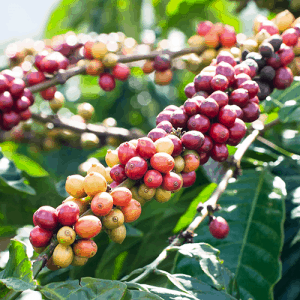 |
Arabica and RobustaThere are only two main species of coffee plants that are used for the world’s coffee production: Arabica and Robusta. Arabica is by far the preferred species and accounts for the vast majority of coffee made worldwide. The mild, aromatice flavor is considered superior. But it is more sensitive to growing conditions, produces a smaller crop per tree, and takes longer for trees to mature, so the price is about double that of Robusta. Robusta, on the other hand, has a more bitter, harsh taste and almost double the caffeine content. The flavor and quality is considered far inferior to Arabica. It is used in instant coffee, most supermarket coffees, and in some blends, including espresso blends. But Robusta is easier to grow, yields more coffee per tree, and is somewhat naturally pest-resistant. Thus the lower price. |
 |
The Bean BeltThe Bean Belt is an area around the middle of the globe, roughly between the Tropics of Cancer and Capricorn. This area provides the best conditions for growing high quality coffee: rich soil, mild temperatures, plenty of rain, and indirect sun. The various combinations of soil, climate and altitude work together to produce many unique and delicious flavors. Arabica thrives in higher altitudes with cooler temperatures. Robusta grows well at relatively lower altitudes and warmer temperatures. Coffee is grown in more than 50 countries. The top 5 producers (by volume) are Brazil, Vietnam, Colombia, Indonesia and Ethiopia. |
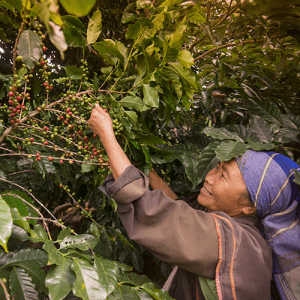 |
HarvestingHarvesting usually happens once per year, when the cherries are removed from the trees in preparation for processing. Selective HarvestingIn Selective Harvesting, only the ripe cherries are removed from the trees, leaving the unripened ones intact. This allows for less waste because the unripe fruit can be picked at a later time. But it is more labor intensive, requiring a person to manually do the selection process. Strip HarvestingIn Strip Harvesting, all the cherries are removed from the branches, regardless of ripeness. The ripe ones are separated and unripe ones are disposed. This produces more waste from cherries that will never be used, but is less time-consuming, whether done by hand or by mechanical harvester. |
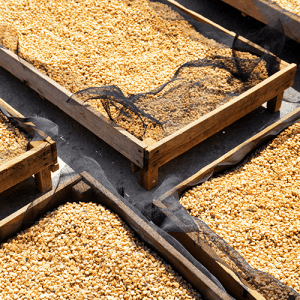 |
ProcessingProcessing begins with the newly harvested coffee cherries and results in dried, unroasted (called ‘green’) coffee beans. DryingThere are a couple methods of processing the fresh cherries. The “dry method” involves simply drying the whole cherries intact. The “wet method” removes the pulp from the cherries first, then ferments the beans before drying them. HullingRegardless of whether the dry or wet method was used, the dried beans have some outer material still attached. The hulling process removes all excess material from the beans. Grading and SortingThe coffee beans are then sorted by size and density. And finally, the beans are packed and ready to ship to coffee buyers. |
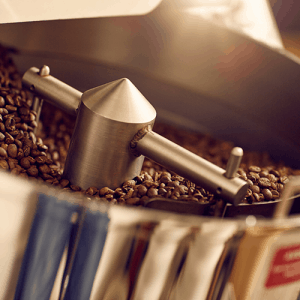 |
RoastingRoasting the green coffee beans is a bit of an art and has a huge impact on the flavor they will produce. High temperature (around 550 degrees Fahrenheit) is used, and the beans are kept in motion so they do not burn. There are a variety of roast levels, from ‘lightly roasted’ to the darkest ‘espresso roast’. The extent of the roast determines the flavor and certain types of coffees require specific roasts. As the roast gets darker, the flavor gets stronger, and the acidity and caffeine decrease. Light Roasts – Examples include Light City, Half City and Cinnamon. Medium Roasts – Examples include City, American, Breakfast. Medium Dark Roasts – Examples include Full City, After Dinner Roast, Vienna Roast. Dark Roasts – Examples include High, Continental, Espresso, Italian, French. |
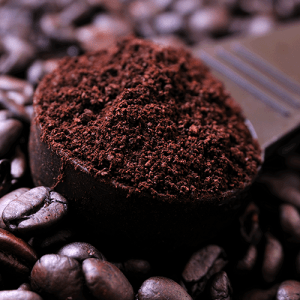 |
GrindingGrinding the roasted beans is the last step before actually making your cup of coffee. We’re almost there! The characteristics of ground coffee have a bigger effect on flavor than many people realize. Here are the important elements of the ‘perfect grind’: (1) the proper grind size for the brewing method to be used; (2) consistent particle size; (3) no exposure to heat during the grinding process; (4) ground as close to the time of brewing as possible. Burr vs. BladeThe grinder is perhaps the most important coffee tool you own, because that’s how much difference a good grind can make. Blade grinders are the most popular home grinder. They are affordable and simple to use, but do not allow much control over grind size. Also, it is almost impossible to get a consistent particle size. Burr grinders are the best and the proof is in the flavor. They are more expensive but give you much more control and precise results. |
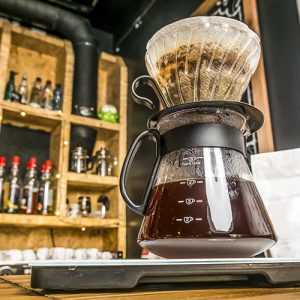 |
BrewingBrewing is the last step in this process that started with the Coffea Tree. There are several common types of brewing methods. Some are very basic and others require expensive equipment, but all can produce delicious coffee. Brewing MethodsInfusion: Ground coffee is steeped (soaked) in hot water. Examples include the french press, coffee bags, and vacuum brewers. Filtration: Gravity carries hot water down and over ground coffee. Examples include drip brewers, electric percolators, cold brewers, and pour overs. Pressure: Steam pressure forces hot water through the coffee grounds. Examples include espresso machines, moka pots, Aeropress, and single-serve machines like Keurig. Decoction: Coffee grounds are boiled in hot water. Examples include Turkish coffee and “Cowboy” coffee. |
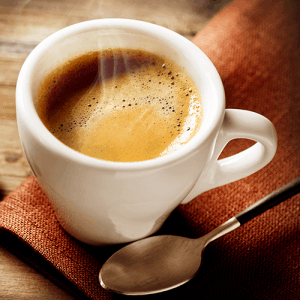 |
Congratulations, you’ve gone from all the way from Bean to Brew! |
